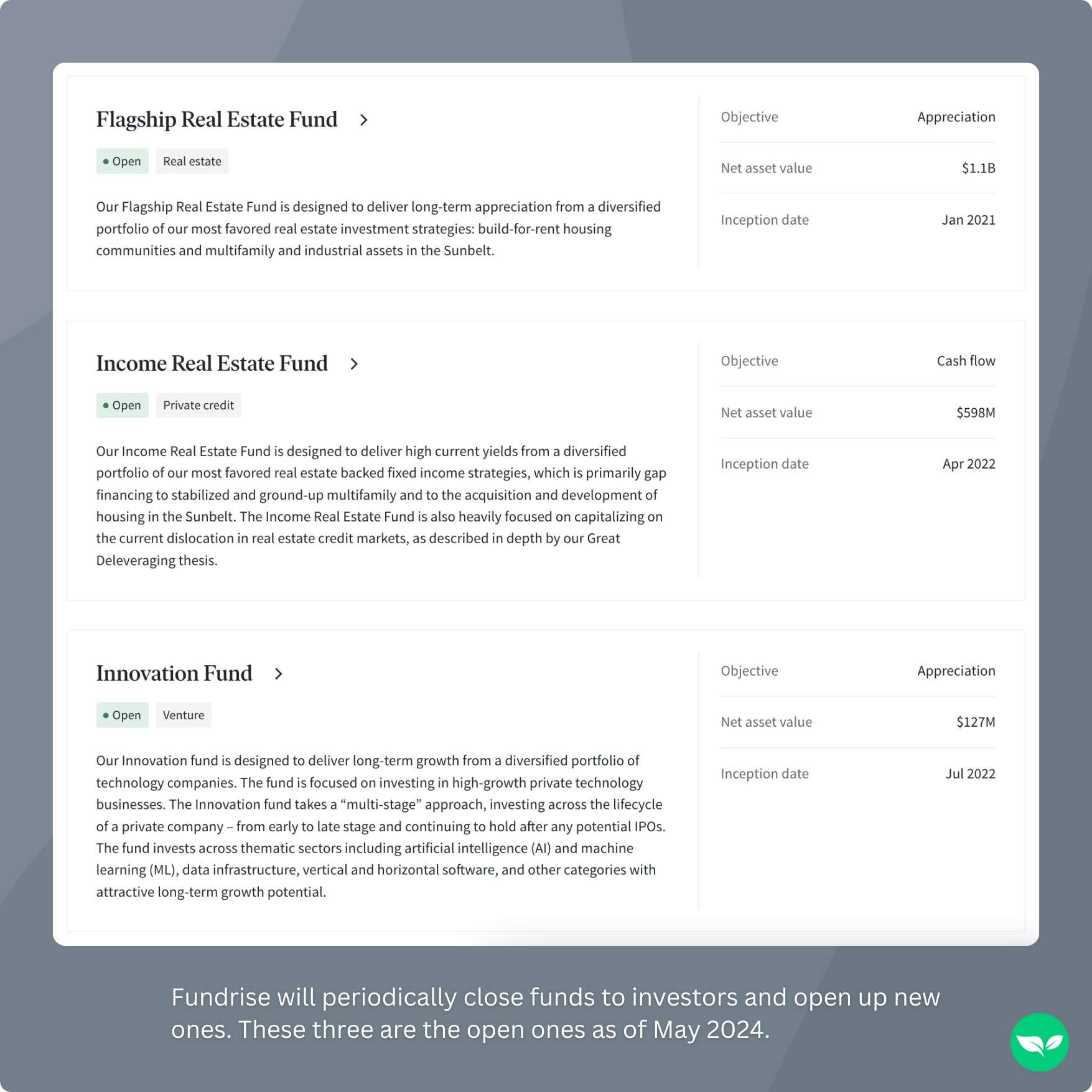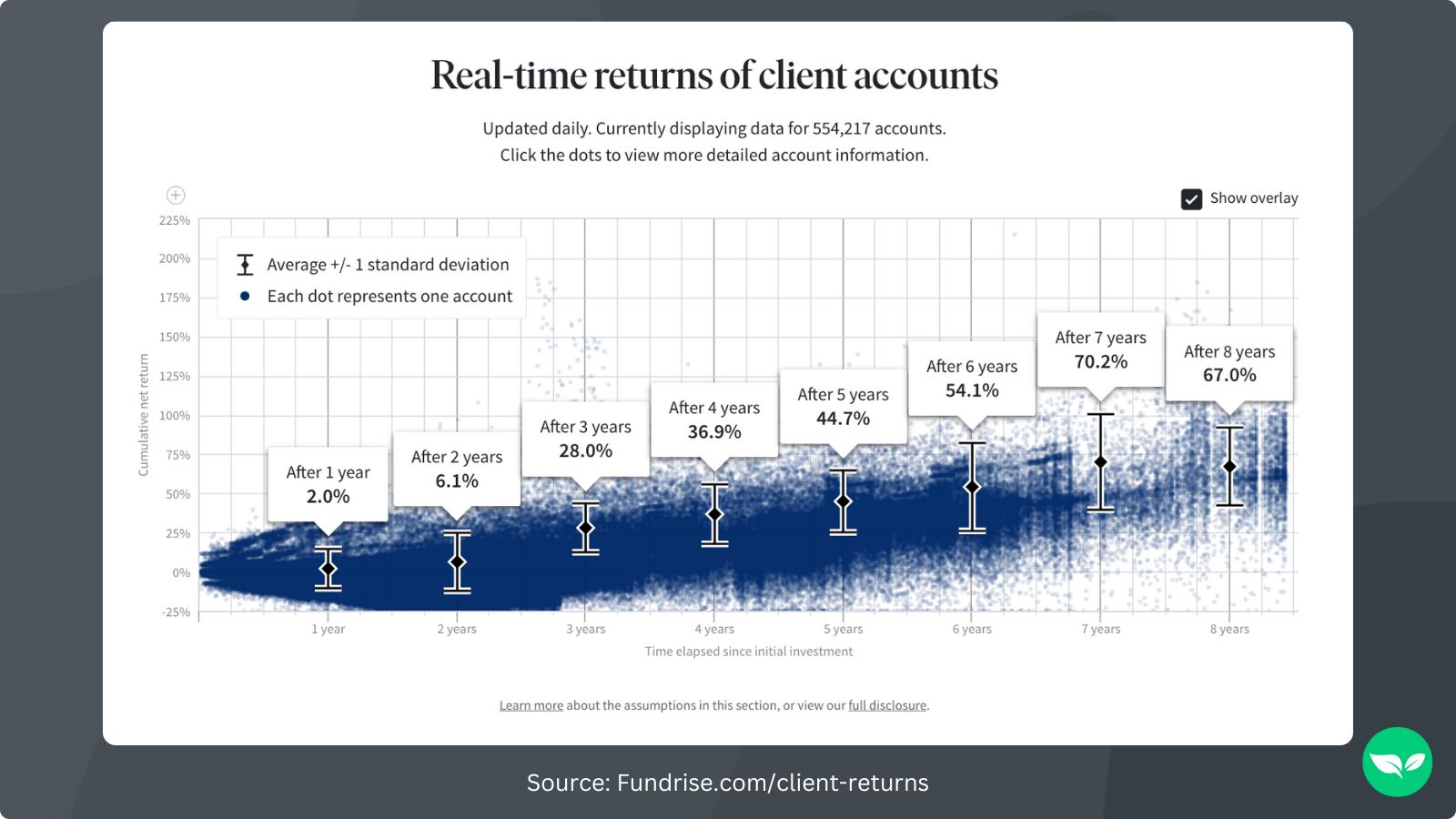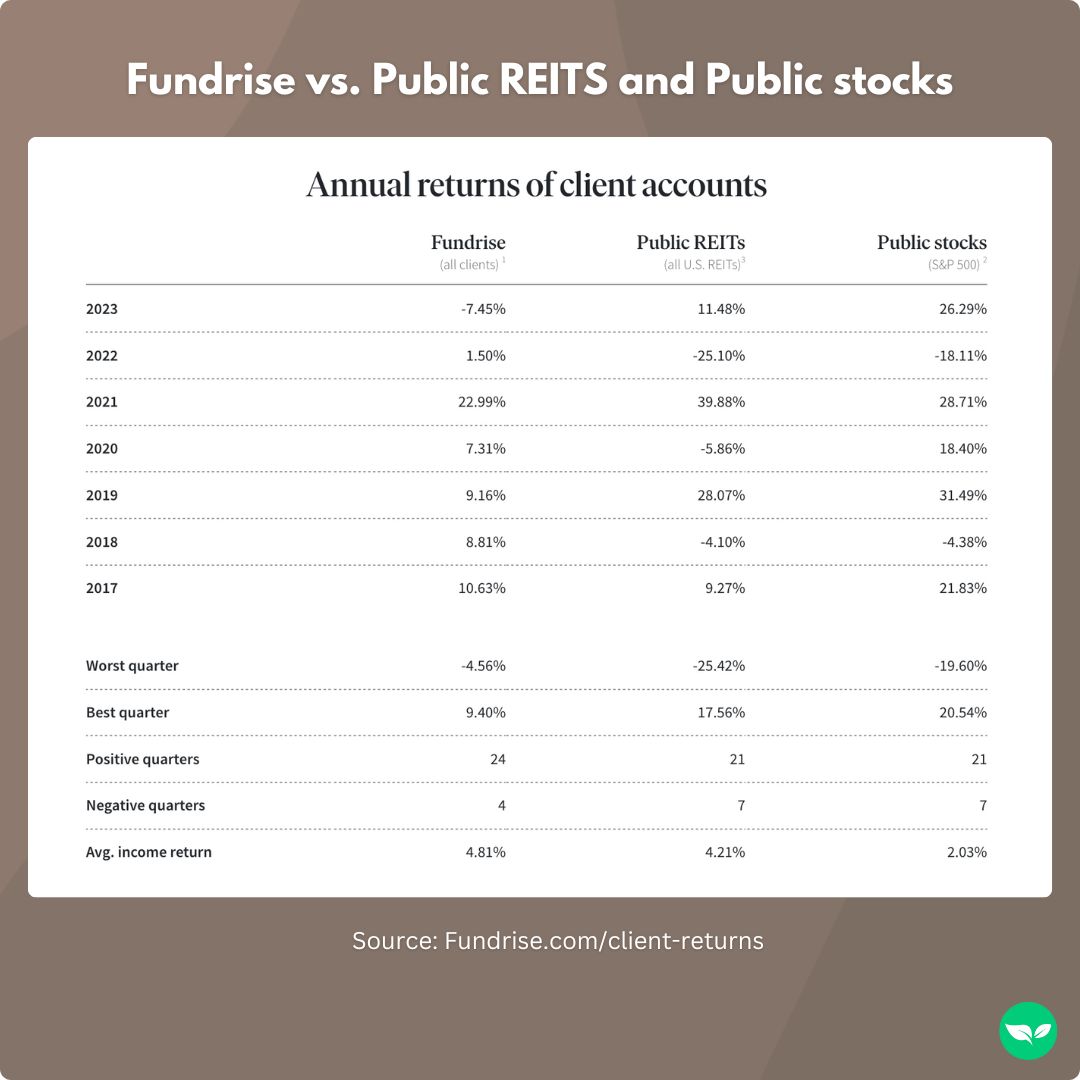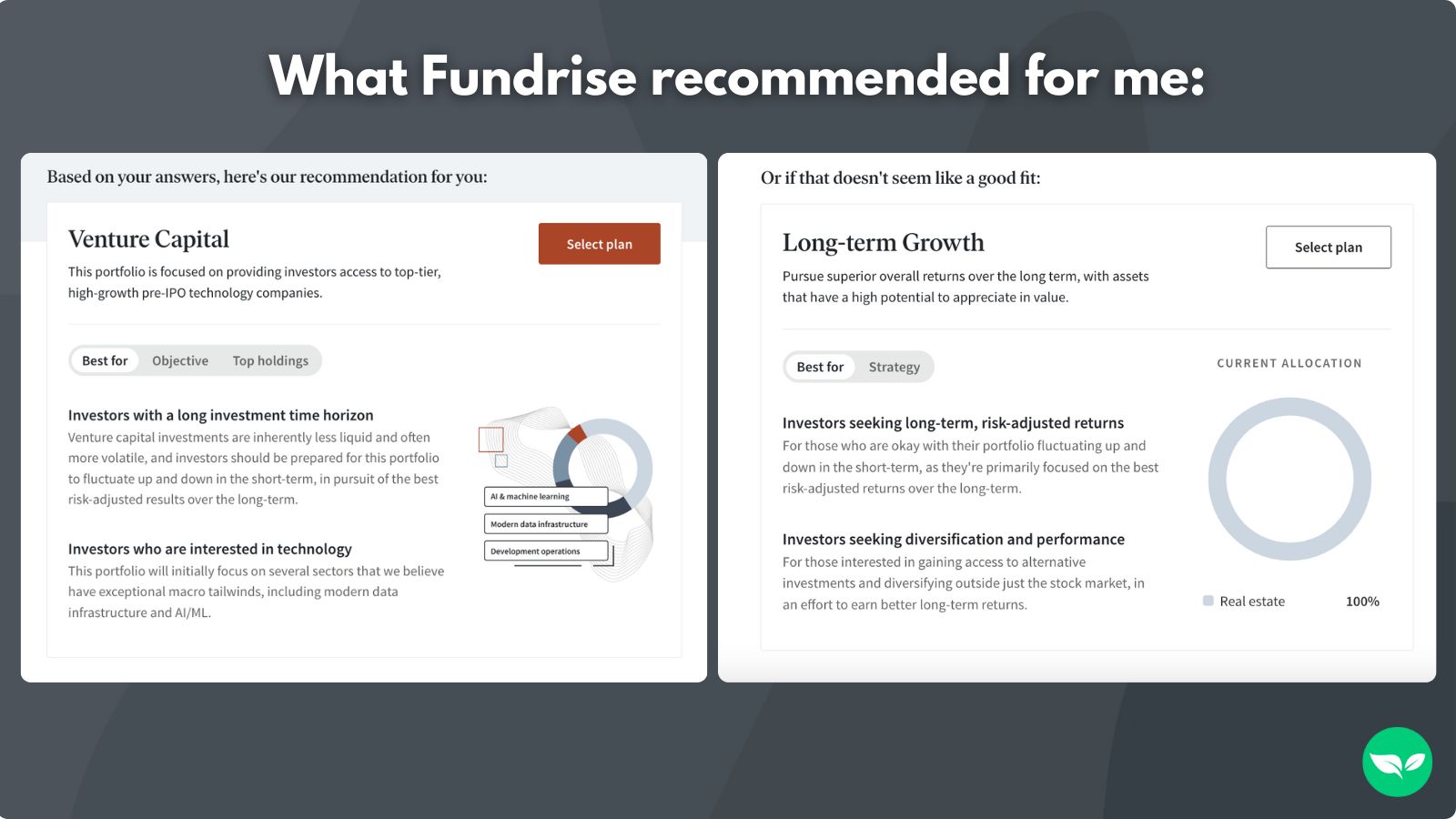Fundrise Review 2025: Risks, Returns & How It Works
Our readers always come first
The content on DollarSprout includes links to our advertising partners. When you read our content and click on one of our partners’ links, and then decide to complete an offer — whether it’s downloading an app, opening an account, or some other action — we may earn a commission from that advertiser, at no extra cost to you.
Our ultimate goal is to educate and inform, not lure you into signing up for certain offers. Compensation from our partners may impact what products we cover and where they appear on the site, but does not have any impact on the objectivity of our reviews or advice.
Fundrise seeks to make investing in real estate (and now venture capital) as easy as possible. Starting at $10, investors can get access to a portfolio of diversified holdings. Here's a look at the risks, possible returns, and what to know before getting started.

Our mission at DollarSprout is to help readers improve their financial lives, and we regularly partner with companies that share that same vision. If a purchase or signup is made through one of our Partners’ links, we may receive compensation for the referral. Learn more here.
Disclosure: I’ve been investing with Fundrise since May 2024. This testimonial is written in partnership with Fundrise, and I earn a commission if you sign up through links in this article. All opinions are my own. While this investment deviates from my usual passive index fund strategy, my time as an investment analyst at a wealth management firm shaped this review. There are no conflicts of interest to disclose.
Investing in real estate can seem daunting, especially for those new to the scene. Platforms like Fundrise are making it easier for everyday investors to enter a market previously only accessible to big players.
Recently, Fundrise has taken a step further by introducing venture capital investing to its suite of services. As both a financial writer and an investor, I was intrigued to see what Fundrise has to offer.
I’ve since explored Fundrise firsthand, diving into its real estate and new venture capital options. Today, I share my experiences with the platform’s costs, potential returns, and risks involved. If you’re considering investing or looking to diversify your portfolio, understanding how Fundrise works can mean the difference between appreciable returns and unwelcome losses.
Fundrise is an online real estate and venture capital investment platform that allows individuals to access investments generally not available to the general public. By pooling investments, Fundrise provides access to these markets with a low minimum investment, making it accessible to a broader range of investors.
Show Hide moreThree Main Offerings from Fundrise
Fundrise provides a range of specialized funds that include real estate private equity, venture capital, and private credit—investment opportunities that, in the past, were typically available only to institutional investors.
The idea here is that since Fundrise has such a large pool of investors, they have more collective power and can access these more exclusive investments. However, exclusive doesn’t always mean better. More on that later.
Investors who choose Fundrise can customize their portfolios based on their specific goals. The offerings include a variety of strategic options such as:
- Developing rental housing in the Sunbelt region,
- Investing in late-stage, high-growth private technology companies, particularly focused on artificial intelligence and machine learning,
- Acquiring industrial properties, including last-mile distribution warehouses and data centers, and
- Engaging in bridge loan financing for real estate deals.
Regardless of which portfolio you choose, Fundrise is designed for long-term investors, especially those who can invest for at least five years. The platform focuses on real estate and venture capital, areas typically not easy to pull money out of quickly. Since it’s not liquid, that also means won’t see your portfolio value fluctuate daily like you would for a normal portfolio of stocks or ETFs.
Recognizing that some investors might occasionally need to access their funds, Fundrise does offer a chance to cash out quarterly without penalty. This setup is designed for people who are prepared to commit their money for the long haul and understand that while their money may grow, accessing it isn’t immediate.
Related: How to Start Real Estate Investing (Beginner’s Guide)
Fundrise Cost & Portfolio Performance
At the end of the day, these are the only two things that I really care about when it comes to investing.
Cost and performance are also the two reasons that I primarily invest in index funds: they are extremely cheap and they match the performance of the market. Beating the market is hard, but matching it is easy. So how does Fundrise stack up?
First off, investing in Fundrise is not cheap.
Every fund has a 0.15% advisory fee, which is already higher than most index funds, but it’s not unreasonable. The real kicker though is the management fee, which is an additional fee on top of the advisory fee. And this is not a small fee.
For real estate funds with Fundrise, the yearly management fee is 0.85%, which means the total fee is 1% of your invested assets, every year, for as long as you invest.
Think of this as compound interest, but instead of working for you, it’s working against you.
The venture capital fund (the Innovation Fund) is even more expensive, with a 1.85% management fee. Add in the advisory fee and you are looking at a 2% yearly fee, which, in my opinion, is almost a deal breaker.
A headwind that strong is difficult to overcome. I know the idea is that it takes significant research and skill to find these possible unicorn tech companies, but this fund tends to invest in late-stage, more mature companies (which have higher valuations to match).
To be fair, none of the companies in the Innovation Fund have gone public yet, so we haven’t had the chance how big those private-to-public valuation jumps will be.
Fee Summary
| Fund Type | Advisory Fee | Management Fee | Total Yearly Fee |
|---|---|---|---|
| Real Estate Funds | 0.15% | 0.85% | 1.00% |
| Innovation Fund (VC) | 0.15% | 1.85% | 2.00% |
| Private Credit | 0.15% | 0.85% | 1.00% |
I do want to note that the fee structure for the Innovation Fund is in line with what other venture capital funds charge, and in many cases, is actually better.
Many VC funds operate on the “2 and 20” model, which means a 2% yearly fee + 20% of the profits.
But just because it’s better, in my opinion, doesn’t necessarily make it worth it. It’s somewhat of an open secret in the financial industry that these fees are ridiculous (I used to work at a firm that charged 1.5 – 2% per year), but the lay investor often knows none the better.
The chart above from Fundrise is a cool feature that I haven’t seen used very often, but I recommend seeing it at this link since it updates daily. The main point that Fundrise wants you to take away from it is that the longer you invest with them, the higher the likelihood that you will achieve a positive return (and the higher those returns will be).
Even with the fees, many investors were able to see positive returns, but it’s important to point out that Fundrise has only been in existence since 2012 and has operated in one of the biggest bull runs in history. That’s not a shot against Fundrise, I just want to point out that some of this performance is likely linked to the fact that the entire market has been pumping.
Since Fundrise is primarily focused on real estate, I don’t think it’s exactly fair to compare it to the S&P 500 index (which is composed of 500 U.S. companies in all industries). When I look at the chart above, here is what stands out to me:
- Avg. income return is higher for Fundrise than both the REIT index and public stocks. Good
- Fundrise appears to be somewhat less volatile. Good
- Fundrise has missed out on some major upswings in the market (2023 and 2019 mainly). Really not good
- Downside protection was great in 2018 and 2022. Good
Overall, a mixed bag of results. The question is, is a mixed bag worth a 1-2% yearly fee, especially when the alternative is to match the market performance (whether it’s a REIT index or the S&P 500 index) with the appropriate index fund at a fraction of the cost?
That’s for you to decide. Personally, I don’t see the value, but I recognize that every investor is different.
Related: 20 Best Passive Income Ideas to Make Extra Money
My Experience Investing with Fundrise
Even though I’m not sold on Fundrise quite yet, I was intrigued by the idea of being able to invest in a venture capital fund. Typically, VC funds are only available to accredited investors.
I also wanted to go through the onboarding process for the purposes of this review.
From start to finish, opening an account took me less than five minutes. 10/10 easy.
After answering a few questions about what my investment goals were (like how long my investment horizon is, what level of risk I am comfortable with, etc.), it recommended the Innovation Fund for me:
I imagine their recommendation algorithm is fairly simple since they only have three open funds at the time of this writing. In all likelihood, here is what I think they recommend:
- Income-focused investors (meaning people who primarily want dividends) will be funneled into the Income Real Estate Fund, with the Flagship Real Estate Fund as an alternative. Lowest risk appetite investors will likely have similar recommendations.
- Growth-focused, higher-risk investors, like me, will be funneled to the Innovation Fund, with the Flagship Real Estate Fund as an alternative.
- Investors primarily focused on real estate will be put in the Flagship Real Estate Fund or the Income Real Estate Fund as an alternative.
These are just my guesses, but I don’t think I’m far off.
Here are some details of the Innovation Fund that was recommended to me:
At first glance, it looks like a great portfolio of companies. But since the fund is so new (it only launched in 2022), I can’t imagine that it got in super early on any of these companies. So my expectations are somewhat tempered. As I mentioned earlier, none of the companies in the Innovation Fund portfolio have IPO’d yet, so we will have to wait and see just how big of a valuation jump we get once that happens.
I wasn’t looking to put a lot of money into Fundrise, at least to start, just because I wanted to test out the platform first. Strictly from a user experience perspective, I would give it a 10/10. Everything is neat, clean, and easy to navigate.
One thing I like about the Account Dashboard in Fundrise is that it contains a feed of cool resources and articles, including content that is specific to the fund I am invested in. I was able to read the Annual Letter to investors of the Innovation Fund and found it quite interesting and accessible for most investors. You might have to look up some terms here and there, but it’s a well-written letter that is meant to be read by normal people.
Liquidity & Redemption Options
Fundrise, catering mainly to long-term investors, does not offer the same level of liquidity as more traditional investments like stocks or bonds. Here’s what you need to know about how Fundrise handles liquidity and redemptions:
Quarterly Redemptions: Fundrise provides a redemption program that allows investors to request withdrawals every quarter. This feature is designed to give some flexibility in what is otherwise a long-term investment. However, it’s important to note that these redemptions are subject to availability. The three open funds do not charge a liquidation fee, but previous Fundrise funds have charged a 1% fee if you liquidate within five years of your initial investment. It’s unclear if waiving the fee is going to be a permanent change going forward, but it’s something to be aware of.
Limitations and Conditions: The ability to withdraw funds is not guaranteed. Fundrise reserves the right to suspend or restrict redemption offers under certain economic conditions. This means if the market is under stress, you might not be able to withdraw your funds during that period.
Planning Ahead: Given these conditions, investors should consider their cash flow needs and regard their investments in Fundrise as illiquid. It’s wise to have a financial cushion elsewhere that you can access easily if immediate needs arise.
Fundrise Advantages
- Low Minimum Investment: Fundrise makes real estate investing accessible with a relatively low minimum investment (only $10 for taxable accounts and $1,000 for retirement accounts), opening up opportunities that were traditionally available only to institutional investors or those with significant capital.
- Diversification: By investing in a variety of real estate projects, including residential, commercial, and industrial properties, Fundrise offers a diversified portfolio that can help reduce risk and enhance potential returns.
- Passive Income: Fundrise provides the potential for passive income through dividends, which are distributed from rental income and other earnings from its real estate investments.
- Transparency: The platform offers high transparency with regular updates on investment performance, property acquisitions, and comprehensive reporting, allowing investors to stay informed about where and how their money is being used.
- Tax Benefits: Investors can benefit from various tax advantages associated with real estate investments, such as depreciation and the potential for tax-deferred or tax-free returns in certain scenarios.
- Professional Management: The investments are professionally managed by Fundrise’s team, reducing the burden on individual investors to manage and make decisions on properties.
- Liquidity Option: Although primarily a long-term investment platform, Fundrise offers a quarterly redemption program, providing an option for liquidity that is not typically available in traditional real estate investments.
Fundrise Disadvantages
- Fees Hurt Returns: Depending on the fund, Fundrise charges between 1-2% of your account balance each year, regardless of whether your account balance goes up or down. Over time, these fees can significantly hurt your overall returns.
- Limited Liquidity: Unlike stocks and bonds that can be sold on the open market relatively easily, Fundrise investments are much less liquid. The quarterly redemption program offers some level of liquidity, but it comes with limitations and potential fees, and redemptions are not guaranteed.
- Long-Term Commitment: Fundrise is best suited for investors who can commit their capital for at least five years. This long-term investment horizon may not be ideal for those who need or prefer quick access to their funds.
- Market Risk: All real estate investments carry inherent market risks, including economic downturns and fluctuations in property values. Fundrise’s investments are no exception, and the value of your investment can decrease (sometimes rapidly) depending on market conditions.
- Dependency on Management Decisions: Since the investments are managed by Fundrise’s team, investors have limited control over individual investment decisions. The success of your investment heavily relies on the management’s ability to choose and manage properties effectively.
- Tax Complications: Real estate investments can lead to complex tax situations. For instance, dividends may be taxed as ordinary income, and the tax benefits of depreciation might require more complicated tax filings.
Alternatives to Fundrise
While investing in real estate is often most easily and cost-effectively achieved through buying REITs within your existing investment accounts, other popular investing apps like RealtyMogul, CrowdStreet, and Roofstock offer specialized alternatives that might suit different investment needs.
Each of these platforms presents unique opportunities and fee structures that could be more aligned with certain investment strategies or preferences.
| Feature | Fundrise | RealtyMogul | CrowdStreet | Roofstock |
|---|---|---|---|---|
| Investment Type | Diversified portfolios of real estate | Commercial real estate, REITs | Commercial real estate properties | Single-family rental properties |
| Minimum Investment | Varies; just $10 for most funds. | $5,000 | $25,000 | As low as $5,000 |
| Fees | 1% (advisory + management fees) | 1% (approx.) | 0.50% – 2.5% (varies by project) | 0.5% or $500 transaction fee, plus property management fees |
| Target Investor | Individuals looking for diversified real estate investment | Individuals and institutions seeking commercial real estate opportunities | Accredited investors interested in direct commercial real estate investments | Individuals looking to buy and manage single-family rental properties |
Is Fundrise Worth It? Here’s My Take
While Fundrise offers an innovative approach to real estate and VC investing that democratizes access to previously inaccessible markets, the platform’s fee structure is a notable drawback. Investors should carefully consider the impact of these fees on potential returns, especially given the other challenges such as limited liquidity and the long-term nature of the investment.
Unless the platform drastically improves its fee structure, I think I will stick to my passive, low-cost index fund strategy for now.
Related: 7 Best Short-Term Investments for Growing Your Money
















